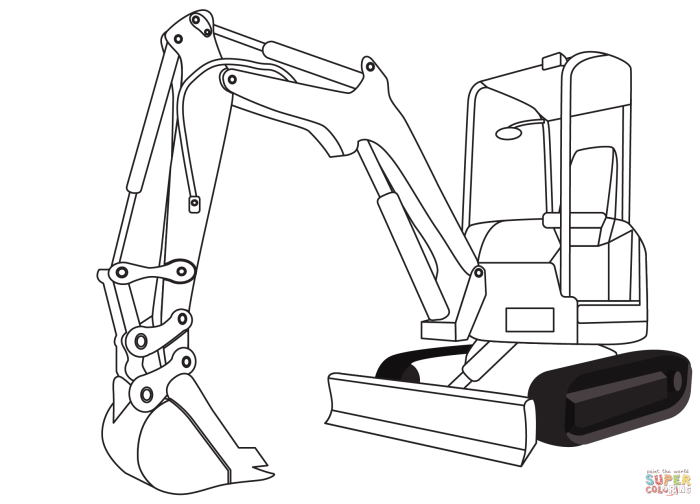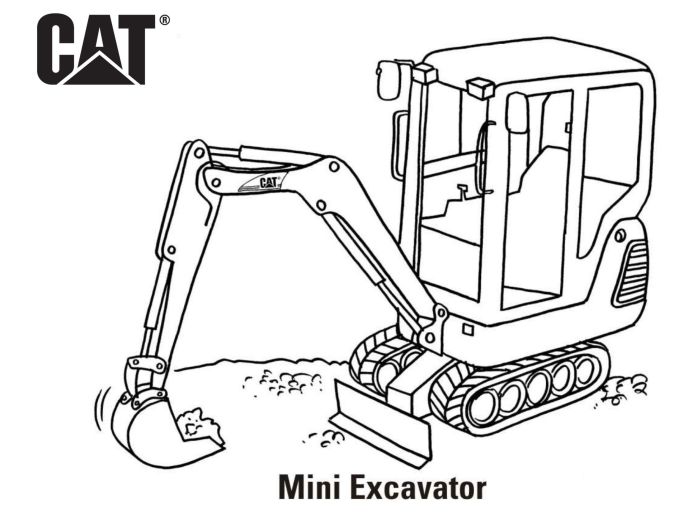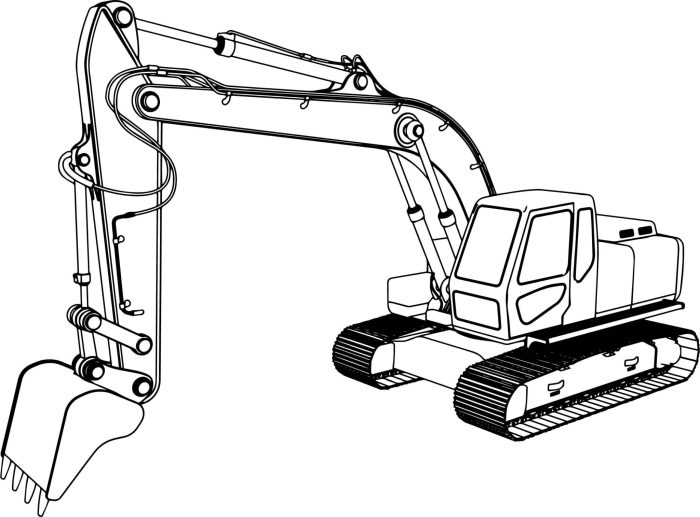Excavator Types and Designs for Coloring Pages

Excavator coloring pages – Creating engaging and educational coloring pages requires careful consideration of design elements. Simple shapes, clear lines, and recognizable features are key to making an excavator coloring page appealing to children of various ages and skill levels. The following sections detail excavator types and design suggestions for creating visually stimulating and age-appropriate coloring pages.
Excavator Types for Coloring Pages
Three distinct excavator types, each with unique features easily represented in a coloring page format, are the crawler excavator, the wheeled excavator, and the long-reach excavator. These variations offer opportunities to showcase different design aspects and functionalities.
- Crawler Excavator: This type features a continuous track system instead of wheels, giving it superior stability and traction on uneven terrain. For the coloring page, depict the tracks as two continuous loops, clearly separated from the body of the excavator. Show the cab prominently, and include a bucket at the end of the arm. The tracks should be simple, easily colored in sections.
- Wheeled Excavator: This excavator is characterized by its wheels, offering increased mobility on paved surfaces and roads. In the coloring page design, emphasize the wheels, depicting them as large and circular, with clear spokes for detail. The body of the excavator should be distinct from the wheels, with a clear connection shown. The bucket arm can be simplified to a single, thick line with a clearly defined bucket at the end.
- Long-Reach Excavator: The defining feature is its exceptionally long arm and bucket, allowing it to reach over obstacles and into confined spaces. For the coloring page, focus on the length of the arm, making it noticeably longer than the other excavator types. The bucket should be proportionally smaller to maintain balance. Simplify the cab and body, focusing on the elongated arm and bucket as the key visual elements.
Mini Excavator Line Drawing for Coloring Pages
A mini excavator, smaller and simpler in design, is ideal for younger children. Imagine a simple rectangular body, slightly wider at the base. Two small circles represent the wheels, positioned near the bottom corners. A short, slightly curved arm extends from the body, ending in a small, scoop-shaped bucket. The cab is a small, rounded square sitting atop the body.
All lines should be bold and clearly defined for easy coloring.
Design Elements for Visually Appealing Excavator Coloring Pages
Several design elements contribute to a visually appealing excavator coloring page. Simple shapes, like rectangles, circles, and triangles, are easier for children to color within the lines. Clear, bold lines create distinct sections, making it easier for children to stay within the boundaries of each part of the excavator. Avoiding excessive detail allows for a focus on the basic shape and function of the machine.
The use of large, uncluttered spaces also makes coloring less frustrating and more enjoyable. A limited color palette, with well-defined sections for each color, helps prevent overwhelming children with too many choices.
Coloring Page Complexity and Age Appropriateness: Excavator Coloring Pages
Designing excavator coloring pages requires careful consideration of age appropriateness and complexity to ensure an engaging and achievable experience for children of different skill levels. The level of detail, the intricacy of the lines, and the color palette should all be tailored to the target age group.Coloring pages should be both stimulating and manageable, encouraging creativity without causing frustration.
A balance between simple shapes and more complex details allows for progressive skill development and maintains interest.
Age Group Categorization and Design Complexity
The complexity of an excavator coloring page should directly correlate with the age and fine motor skills of the child. Preschoolers will benefit from simple, large shapes, while older children can handle more intricate designs and smaller details.
- Preschool (Ages 3-5): These pages should feature large, bold Artikels of excavators, using basic shapes like squares, rectangles, and circles. Minimal detail is ideal, focusing on simple forms and large areas to color. An example would be a simplified front-end loader with a single bucket, large tires, and a simple cabin.
- Elementary School (Ages 6-8): Slightly more complex designs can be introduced here. These pages might include more detailed features like treads on a crawler excavator, more defined cab shapes, and perhaps some additional machinery details, such as a hydraulic arm with a separate bucket. Lines can be slightly thinner but should remain easy to follow.
- Older Children (Ages 9-12): These coloring pages can incorporate much finer details, such as rivets, textures on the metal, and complex machinery parts. Perspective can be added, and the designs can include background elements or additional equipment. A detailed illustration of an excavator working on a construction site would be suitable here.
Suitable Color Palettes for Each Age Group
The choice of color palette also plays a significant role in the coloring experience. Brighter, bolder colors are generally more appealing to younger children, while older children might appreciate a wider range of shades and more nuanced color combinations.
- Preschool: Primary colors (red, yellow, blue) and their simple mixes (orange, green, purple) are ideal. These colors are easily identifiable and provide a strong visual impact. The use of bright, saturated tones enhances the overall vibrancy.
- Elementary School: Expand the palette to include secondary and tertiary colors, introducing more subtle shades and variations. Earth tones (browns, greens, beiges) can be incorporated to represent the environment where excavators operate. The introduction of lighter and darker shades of the primary colors allows for more shading and depth.
- Older Children: A broader range of colors and shades is appropriate here. Metallic colors (silver, gold, bronze) can be introduced to add realism to the excavator’s metal parts. Consider including more muted tones and experimenting with color gradients for added complexity and visual interest. For example, using various shades of blue to depict the sky or different greens for the surrounding vegetation.
Coloring Page with Hidden Details or a Puzzle Element
This excavator coloring page depicts a large excavator working on a construction site. The excavator itself is highly detailed, including treads, hydraulic arms, and a detailed cab. Hidden within the scene are five small construction workers, each wearing a different colored hard hat. The challenge for the child is to find all five workers. The color palette for this page should be realistic, including earth tones for the ground, metallic colors for the excavator, and bright colors for the workers’ hard hats.
This design promotes observation skills and problem-solving abilities. The background could subtly include construction equipment or buildings, further adding to the complexity and visual appeal.
Creating Engaging Coloring Page Scenes
Designing captivating coloring page scenes requires careful consideration of the setting and elements included to maintain child engagement and provide a stimulating creative experience. The goal is to create visually appealing and thematically relevant images that inspire children to color and engage with the excavator theme. Different scenarios can greatly enhance the coloring page’s appeal.
The following examples demonstrate how to create engaging scenes that incorporate the excavator within diverse and exciting contexts, fostering creativity and imaginative play.
Excavator on a Construction Site
This scene depicts a busy construction site teeming with activity. A large excavator, possibly a hydraulic model, is shown digging a foundation or moving earth. Surrounding the excavator are various other construction vehicles, such as dump trucks carrying loads of dirt or gravel, and cement mixers. In the background, partially completed buildings rise towards the sky, showcasing the progress of the construction project.
Excavator coloring pages offer a fun way for children to explore the world of heavy machinery. If you’re looking for a wider variety of subjects, however, you might also enjoy the whimsical designs found in coloring pages of doodles ; they offer a nice contrast to the more structured lines of an excavator. Returning to the subject of excavators, remember that these coloring pages can be a great educational tool, too, introducing children to different types of construction equipment.
A few construction workers, simply represented, are visible, adding to the bustling atmosphere. The scene should include a variety of textures and details to stimulate coloring, such as the rough texture of the concrete, the smooth surfaces of the vehicles, and the intricate details of the excavator’s machinery. The color palette could include earth tones (browns, yellows, oranges) for the dirt and buildings, and bright colors for the vehicles and construction equipment.
Excavator in a Natural Setting
This scene features an excavator in a serene natural environment. Imagine a powerful excavator carefully clearing a path through a dense forest, perhaps preparing the ground for a new nature trail or helping with reforestation efforts. The excavator is depicted working delicately amidst lush green trees and vibrant wildflowers. A clear blue sky provides a stark contrast to the green foliage.
Birds might be shown in the trees, adding a sense of tranquility. This scene emphasizes the excavator’s versatility and positive impact, even outside a typical construction context. The coloring page could use calming, nature-inspired colors, with varying shades of green for the foliage, brown for the tree trunks, and a light blue for the sky.
Excavator in a Rescue Operation
This scene showcases an excavator playing a crucial role in a rescue mission. Perhaps the excavator is carefully removing debris from a collapsed structure to reach trapped individuals. The scene could include a team of rescue workers and the excavator’s claw gently lifting a section of rubble. A sense of urgency and hope should permeate the image, emphasizing the positive impact of the excavator and the dedication of the rescue team.
The color palette could incorporate vibrant colors to represent the rescue workers’ uniforms and equipment, while muted colors could be used for the debris field to maintain a sense of seriousness. The overall image should communicate a message of hope and resilience.
Presenting the Coloring Pages

Creating a user-friendly experience for accessing and utilizing the excavator coloring pages involves careful consideration of both the printable PDF format and the online presentation. The goal is to make the pages easily accessible and enjoyable for users of all technical abilities.The effective presentation of the coloring pages requires a strategic approach encompassing both print and digital mediums. This ensures broad accessibility and caters to diverse user preferences.
PDF Document Layout and Formatting
The three excavator coloring pages will be organized into a single, easily printable PDF document. Each page will be allocated a full page within the PDF, ensuring ample space for coloring and preventing any overcrowding. The pages will be arranged in a logical sequence, starting with a simpler design and progressing to more complex ones. The document’s margins will be set to 0.5 inches on all sides to maximize printable area.
The PDF will be created in landscape orientation to best accommodate the horizontal nature of many excavator designs. The file name will be descriptive, such as “ExcavatorColoringPages.pdf”. The file size will be optimized for fast download and printing.
Website Layout Showcasing Coloring Pages
The website will feature a clean and simple design, prioritizing ease of navigation. A header will contain the title “Excavator Coloring Pages”. The main content area will display thumbnails of the three coloring pages, each approximately 200 pixels wide by 150 pixels high. Each thumbnail will be a high-quality JPEG image, providing a clear preview of the coloring page’s content.
Under each thumbnail will be a concise description of the excavator type depicted (e.g., “Mini Excavator,” “Hydraulic Excavator,” “Wheeled Excavator”). Below the descriptions, a “Print” button will link directly to the full-size, printable PDF version of that specific coloring page. The footer will include copyright information and a link to a potential “About Us” page (if applicable).
HTML Table for Displaying Coloring Pages, Excavator coloring pages
The following HTML table code will display thumbnails of the coloring pages in a responsive four-column layout. Each thumbnail will link to a larger, printable version of the coloring page. The table will adjust its layout to fit various screen sizes.
 |
 |
 |
This code provides a basic framework. The image source paths (“excavator1_thumb.jpg”, etc.) and PDF links (“excavator1.pdf”, etc.) would need to be adjusted to reflect the actual file names and locations. The empty
Illustrative Details for Excavators

Adding texture and detail to your excavator coloring pages will significantly enhance the overall engagement and creativity of the activity. By incorporating various textures and shading techniques, children can explore their artistic skills and create truly unique and visually appealing designs. The following suggestions provide a framework for achieving this.
The different parts of an excavator offer a multitude of opportunities for textural exploration. Consider the metallic sheen of the body, the rough texture of the treads, and the intricate details of the hydraulic arms. These varied surfaces provide a canvas for a range of coloring techniques, allowing for a more realistic and engaging final product.
Texture and Pattern Suggestions for Excavators
To enrich the coloring experience, a variety of textures and patterns can be suggested for different excavator components. This adds depth and visual interest to the final artwork.
- Body: Smooth, metallic, with subtle scratches or dents to suggest wear and tear. Consider adding a subtle pattern of rivets or weld lines.
- Treads: Rough, textured, with deep grooves and patterns to indicate the gripping surface. Consider using cross-hatching or stippling to depict the tread’s texture.
- Bucket: Slightly rough, possibly with patches of dirt or rust. The inside of the bucket might show signs of wear from the material it scoops.
- Hydraulic Arms: Smooth, metallic, with visible joints and hinges. Consider adding shading to highlight the cylindrical shape of the arms.
- Cab: Smooth, possibly with windows that reflect light, or a textured surface to indicate the material (e.g., metal, glass).
Descriptive Words to Encourage Creative Coloring
Providing a list of descriptive words can inspire children to explore a wider range of colors and techniques, adding depth and personality to their drawings.
- For Metal Surfaces: Gleaming, shiny, polished, rusty, weathered, scratched, dented, chrome, brushed steel, metallic, dull.
- For Rubber/Tire Surfaces: Grippy, worn, muddy, dusty, black, dark grey, speckled.
- For Ground/Dirt: Muddy, dusty, sandy, brown, dark brown, earthy, damp, dry.
- For Overall Appearance: Powerful, strong, dirty, clean, bright, vibrant, faded, aged.
Depicting Light and Shadow on an Excavator
Simple shading techniques can significantly enhance the three-dimensionality of the excavator. Even young children can master these techniques to add depth and realism to their artwork.
A simple method is to use darker shades of the base color on the sides of the excavator that are facing away from the light source, and lighter shades on the sides facing the light. This creates a sense of volume and form. For example, if the light source is from the upper left, the upper right side of the excavator would be darker, while the upper left side would be lighter.
This technique can be applied to all parts of the excavator, including the bucket, arms, and treads. Consider adding a very light highlight to the areas that receive the most direct light.
